
UGC Ads: Create Ads That Work (+ Examples)
June 11, 2025

Written By Zain Zia

Edited By Katja Orel
Lead Editor, UGC Marketing

Fact Checked By Sebastian Novin
Co-Founder & COO, Influee
Two reasons why UGC ads have been on the rise: they cost less compared to traditional ads.
And better yet, unlike traditional ads, they don't cause ad fatigue.
People crave authenticity, and UGC ads deliver exactly that—real people, real experiences, and real results.
That’s why brands using UGC see higher trust, better engagement, and lower ad costs compared to traditional advertising.
If you’re wondering what makes UGC ads such a powerful tool and how top brands are using them, you’re in the right place. We break it down with examples, tips, and stats to help you get started.
Key Takeaways:
- User-generated content (UGC) ads are advertisements featuring authentic content created by real customers and creators rather than brands themselves.
- UGC ads get 4x higher click-through rates and 50% lower cost-per-click than standard ads.
- 79% of consumers say UGC influences their purchases, and 92% trust peer recommendations over branded content.
- Popular UGC formats include short-form videos, influencer collaborations, social media campaigns, and customer testimonials, driving 28% higher engagement.
- The key to creating high-quality UGC ads is to focus on authentic and relatable hooks, seamless branding, and clear calls to action that motivate viewers to take immediate action.
- Brands like Airbnb, Apple, and Nike use UGC to build trust and grow their communities with millions of user-generated posts.
UGC videos starting at $80

12900+ Vetted Creators in USA
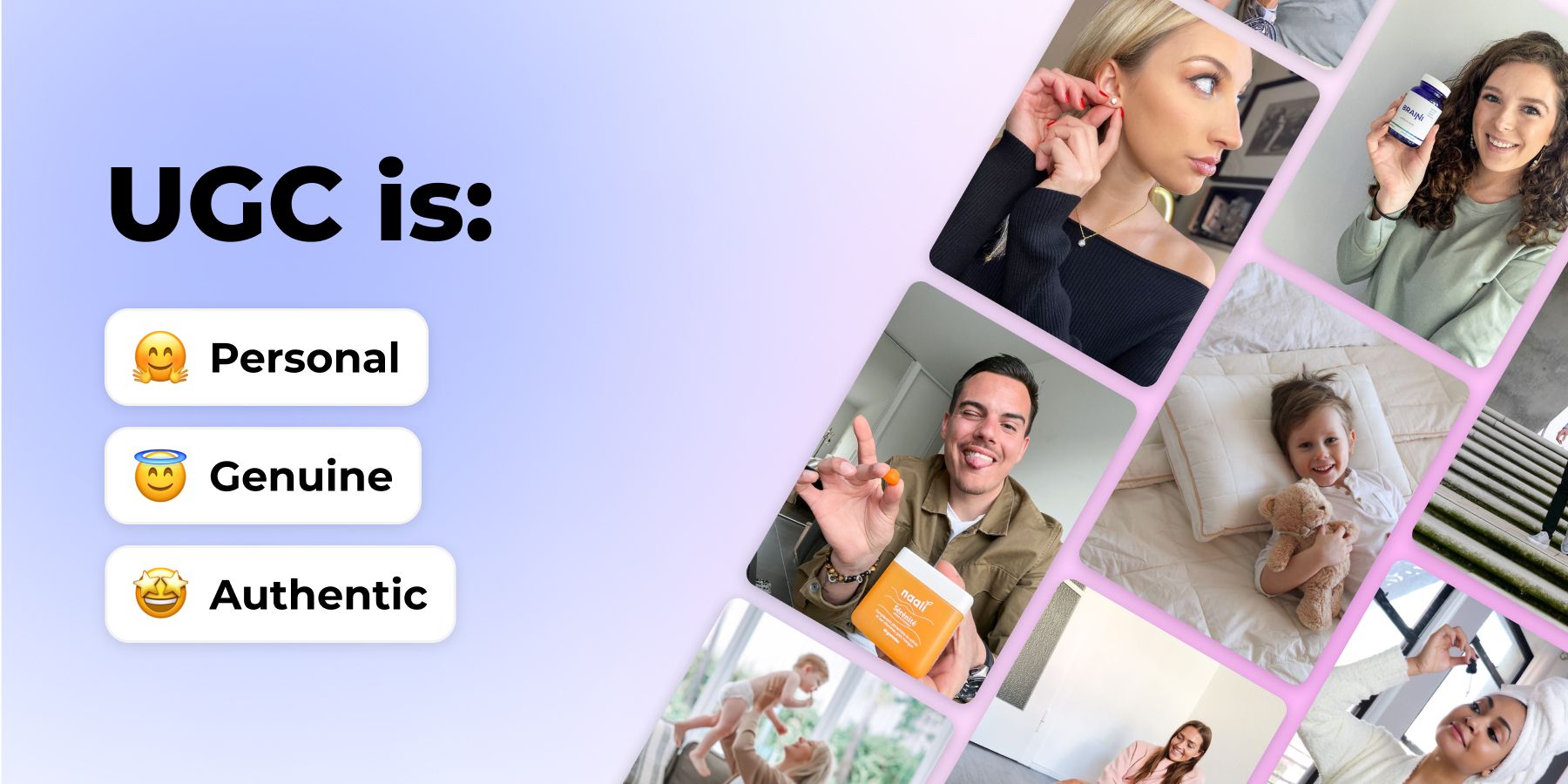
What Are UGC Ads?
UGC ads are advertisements that feature content made by customers, fans, and creators - not brands - including testimonials, videos, and photos that naturally build trust and drive conversions.
UGC ad creation relies on real, authentic content. Since they blend naturally into any ad campaign, incorporating UGC has become a go-to strategy for social media, influencer marketing, and review platforms.
Statistics, trends, and studies show that traditional advertising just doesn't cut it for people anymore, and they are more likely to rely on peer recommendations and reviews before making a purchase.
This trust makes UGC a game-changer for brands that want to connect with their target audience more effectively.
By making UGC a key strategy of their marketing campaigns, businesses can increase engagement, build credibility, and increase conversions—all while letting their customers do the talking.
That's the real value of UGC in advertising, which makes UGC worth it for brands. Let's have a closer look at how powerful UGC really is.
How to create UGC Ads?
There are three main ways to create UGC ads:
- Get content from UGC creators: Partner with professional, vetted UGC creators who specialize in content creation and producing the best UGC for brands.
- Source content from customers: Repurpose existing customer photos, videos, and reviews from social media and review platforms.
- Create AI UGC ads: Use AI UGC video tools to generate realistic user-generated style content with voiceovers and visuals based on scripts or brand guidelines.
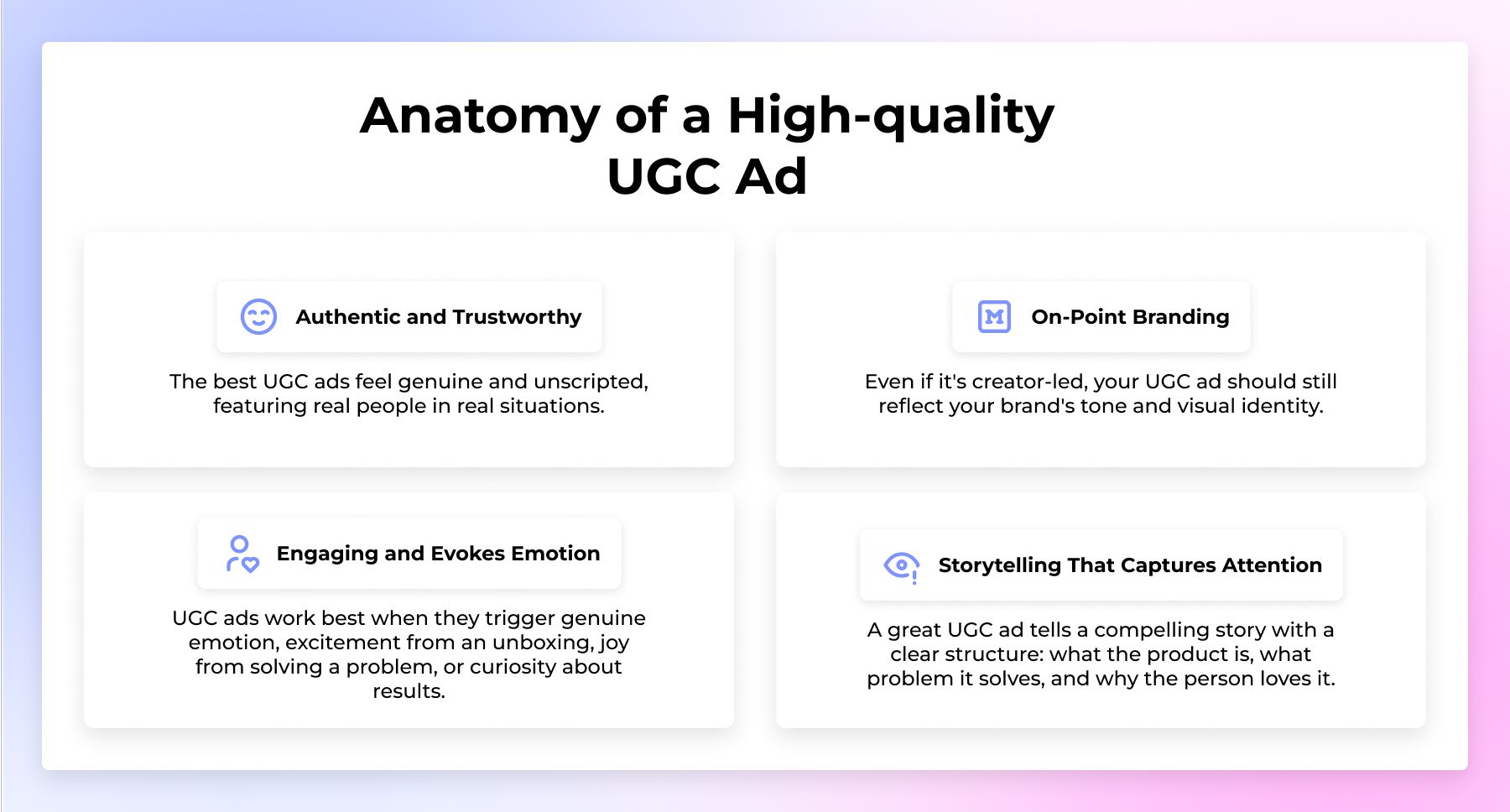
Anatomy of a High-quality UGC Ad
Understanding what makes UGC ads effective helps you create content that converts. Here are the key elements every successful UGC ad needs:
1. Authentic and Trustworthy
The best UGC ads feel genuine and unscripted, featuring real people in real situations. They don't look overly produced or staged, which helps maintain an authentic brand image that resonates with viewers.
Audiences are quick to spot fake or overly polished content, and they tend to tune it out. By keeping it raw and relatable, these ads build instant credibility, making viewers more likely to trust the brand and take action.
2. On-Point Branding
Even if it's creator-led, your UGC ad should still reflect your brand's tone and visual identity. The key is subtle integration—your logo, colors, or messaging should appear naturally without disrupting the authentic feel while remaining visually appealing to your target audience.
When done right, viewers absorb your brand elements subconsciously while staying engaged with the genuine, relatable content that makes UGC so powerful.
3. Engaging and Sparks Emotion
UGC ads work best when they trigger genuine emotion—excitement from an unboxing, joy from solving a problem, or curiosity about results.
These authentic emotional moments create instant connection and drive viewers to take action. It's this ability to reflect positive experiences that makes UGC so effective in brand storytelling.
4. Storytelling That Captures Attention
A great UGC ad tells a compelling story with a clear structure: what the product is, what problem it solves, and why the person loves it. Attention spans are short, so aim to hook viewers in the first 3 seconds.
Here's a quick example: in your ad campaigns, don't just promote a feature. Instead, highlight the user experiences that show how your product or service solves real problems.
Poor UGC ads typically lack authenticity (viewers can tell when content feels forced or scripted), poor video quality (blurry footage or bad audio destroys credibility), and unclear messaging without strong hooks or calls to action (leaving viewers confused about what action to take).
These elements work against UGC's natural strengths and can actually harm your brand's credibility rather than enhance it. It's important to note that the most effective UGC ads require careful curation to align with brand values and audience preferences. Follow our UGC ads tips to avoid making poor-quality ads.
Types of UGC Ads
Let's have a look at the different types of UGC ads.
1. UGC Video Ads
Short-form UGC video ads like Spark Ads on TikTok, Instagram Reels, and YouTube Shorts are some of the most effective ad formats out there because they're fast, real, and engaging.
Video content gets 1,200% more shares than text and images combined, and UGC videos drive 10x higher engagement than traditional brand ads.
Their secret? They blend right into social feeds, avoiding the "ad fatigue" that overly polished and produced ads create.
On top of that, UGC video ads boost watch time and conversions by showing real people using products in everyday situations—whether it's an unboxing, a testimonial, or a quick tutorial.
The result? A more authentic, relatable experience that builds trust and drives action.
2. Influencer Marketing
Brands team up with micro and macro influencers to create UGC-style ads that feel natural—more like organic content than traditional promotions. These ads seamlessly blend into social feeds, keeping authenticity intact while leveraging the trust influencers have with their audience.
Micro-influencers, in particular, drive 60% higher engagement than larger influencers, making them a game-changer for UGC campaigns. Featuring real people using a product in everyday scenarios makes these ads feel like personal recommendations, leading to higher conversions and stronger brand loyalty.
Beyond direct influencer partnerships, many brands also work with creator-focused agencies, such as inBeat, that specialize in bridging strategy, creator sourcing, and performance optimization. These agencies help identify high-performing micro-influencers, guide creators on storytelling formats that convert, and ensure the resulting UGC feels natural, trustworthy, and aligned with the brand’s goals. By providing creative direction and performance testing, they help brands scale influencer-driven UGC ads more efficiently across TikTok, Instagram, and other social platforms.
3. Social Media Platforms
Instagram, TikTok, and Facebook are gold mines for UGC social media ads—these platforms run on real, user-generated content. That’s why brands repurpose customer posts, reviews, and unboxing videos into high-performing paid social campaigns.
With 79% of people saying UGC influences their buying decisions, these ads feel more relatable, build trust, and blend naturally into social feeds.
Whether it’s a testimonial for TikTok ads, an Instagram Story demo, or a Facebook review-turned-ad, UGC campaigns drive higher engagement, lower CPC, and stronger conversions than traditional brand content.
4. Online Reviews and Comments
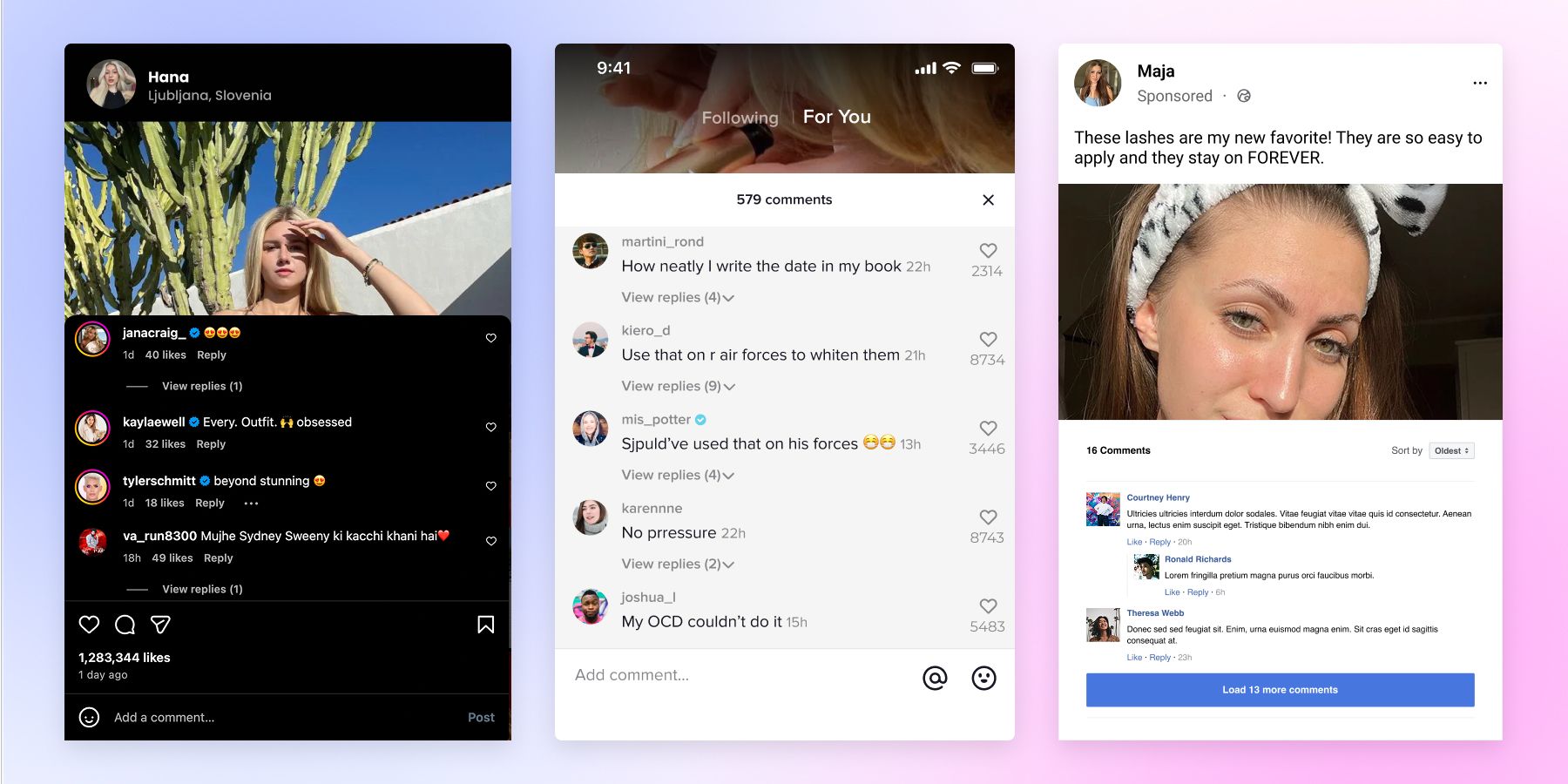
Reviews and comments from actual customers create some of the most trustworthy user-generated content (UGC) ads.
Highlight positive feedback, such as five-star ratings and glowing reviews, by turning it into eye-catching quote graphics or video overlays—instant social proof that builds trust and creates visually appealing content.
But let's be real, not every comment will be sunshine and rainbows. Negative or inappropriate UGC should be moderated to maintain brand integrity too. When you address negative feedback openly and show how you resolved issues, you're proving that your brand actually listens and cares, which often turns skeptics into your biggest advocates.
6 Benefits of UGC Ads
Here's why brands are making user-generated content an important part of their marketing strategy:
1. Authentic, Raw Content
People engage more with UGC-style ads that feel real and unfiltered. 79% say UGC influences their buying decisions because it seems more authentic than brand-made ads.
UGC ads show real people using products in everyday life, making them relatable and trustworthy. Unlike overly polished brand ads, they drive 28% higher engagement and build a stronger emotional connection with potential buyers. Authenticity is the magic ingredient that sets UGC apart from conventional advertisements.
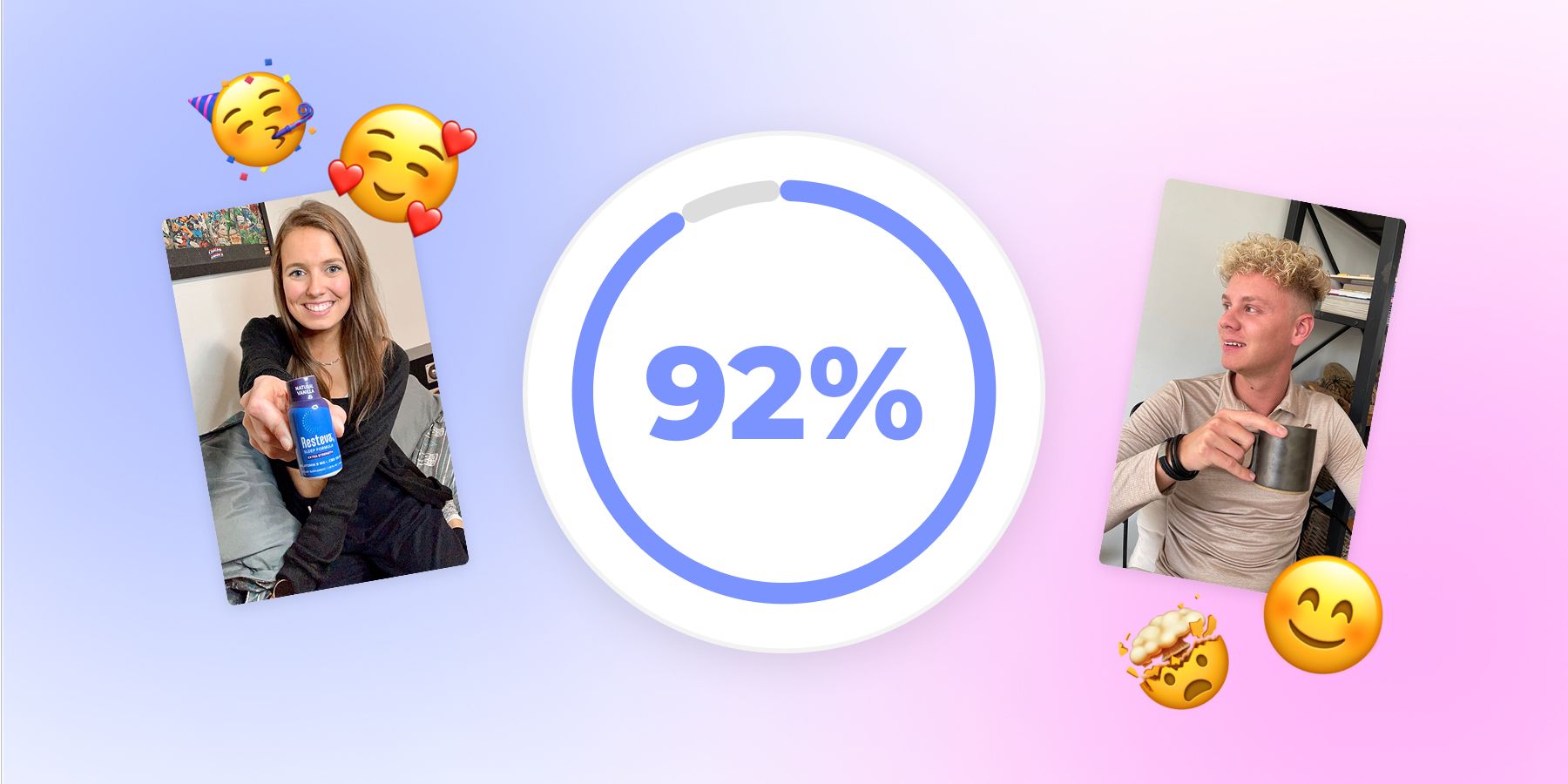
2. Audience Trust
People trust people, not brands. That's why UGC ad creatives are a marketing powerhouse.
92% of consumers trust peer recommendations over the typical ads we're used to. Real experiences and testimonials build credibility, strengthen brand trust, and drive conversions better than polished brand campaigns ever could. But there's more; 68% of consumers trust a brand more after seeing user-generated content associated with it.
3. Increased ROI and Conversions
UGC ads beat brand-created content because they tap into social proof to drive real action.
Studies show they rack up 4x higher CTRs than conventional ads and cut cost-per-click (CPC) by up to 50%.
The fact is that people trust real experiences over fake, acted, or made-up brand messages.
If you're looking for a high-impact, budget-friendly way to boost engagement and conversions, UGC ads are the way to go.

4. Increased Engagement
UGC ads fit right into social feeds, making them feel like organic content rather than obvious ads. That's why they boost engagement by 28% over brand-created ads.
People are 2.4x more likely to like, comment, or share UGC because it feels more real, relatable, and worth engaging with.
5. Credibility
You can't fake authenticity, but you can amplify it.
UGC-style content boosts credibility by 2.4x by featuring real customers and their genuine experiences. Authentic testimonials and user feedback build trust, strengthen brand reputation, and drive conversions—consumers are 2x more likely to trust UGC over brand-created content.

6. Cost-Effective
Creating high-quality brand content is expensive and time-consuming, but UGC ads are a scalable, budget-friendly alternative.
Brands using UGC cut content costs by up to 50% while getting a steady flow of fresh, authentic material that actually connects with audiences. It's a smart, high-ROI move for businesses of all sizes.
UGC videos starting at $80

12900+ Vetted Creators in USA
How to Use UGC in Facebook Ads
User-generated content isn't just for show. When used strategically across marketing channels, especially in Facebook and Meta Partnership Ads, it can be a powerful driver of performance.
- Sourcing from UGC Creators: The most reliable approach is partnering with professional UGC creators who understand your brand guidelines and can produce high-quality, authentic-looking content on demand. This ensures consistency, legal compliance, and content that's optimized for ad performance.
- Using Customer Content: While you can repurpose existing customer posts, this approach comes with challenges. In our experience, customer-generated content often lacks the quality needed for paid advertising and creates a legal issue around usage rights. However, incorporating UGC from customers works excellently for organic social proof, brand awareness campaigns, and building credibility on your website and social channels.
Best Practice: Always secure proper usage rights, maintain quality standards for the best UGC, and test different approaches when choosing between professional UGC creators and customer-sourced content to see what works best for your campaign goals.
UGC videos starting at $80

12900+ Vetted Creators in USA
UGC Ads Examples from Successful UGC Campaigns
Need inspiration for your next campaign? Explore these 10 creative UGC ideas to see what's working for other brands across social media platforms like TikTok, Instagram, and YouTube Shorts.
Airbnb & #AirbnbExperiences Campaign

Airbnb thrives on user-generated content (UGC) by showcasing real travelers’ experiences and repurposing guest-generated photos and videos to promote destinations in a personal and inspiring way.
What it was: The #AirbnbExperiences UGC ad campaign encouraged users to share adventures, from treehouse stays to local cooking classes and guided tours.
Why it worked: Generated 250,000+ Instagram posts by showcasing authentic experiences rather than just properties, positioning Airbnb as an experience platform, not just lodging.
Key takeaway: Expand your brand narrative beyond core product features to capture lifestyle and emotional benefits.
Apple & #ShotOniPhone Campaign
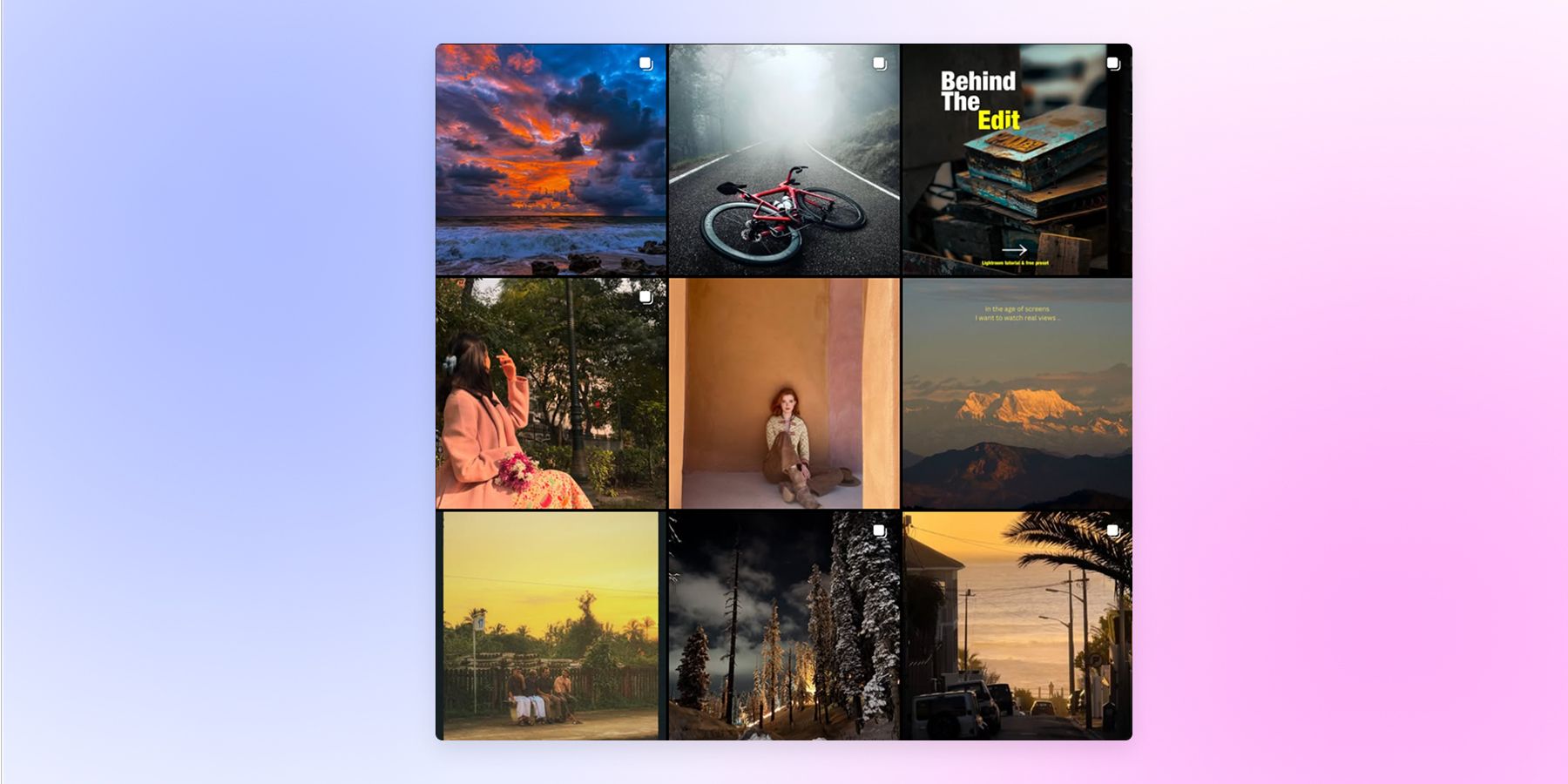
Apple's #ShotOniPhone campaign demonstrates how UGC can serve as powerful product proof, turning customers into credible advocates for technical capabilities.
What it was: The campaign invited iPhone users to submit their best photos, which Apple later featured on billboards, print ads, and online platforms to showcase camera quality.
Why it worked: 6 million Instagram posts and 6.5 billion impressions proved product capability through real user results, not marketing claims.
Key takeaway: Let your product's performance speak through customer results rather than brand messaging.
Nike & #JustDoIt Campaign

Nike has mastered UGC marketing by amplifying real stories that align with their brand values to create emotional connections beyond product features.
What it was: The campaign encouraged athletes and everyday users to share fitness milestones and personal triumphs using Nike's iconic slogan across social media platforms.
Why it worked: 20.8 million Instagram posts transformed a tagline into authentic stories of perseverance, building a community around shared values rather than just athletic gear.
Key takeaway: Turn brand messaging into a movement by connecting with universal human experience. People buy into stories and values, not just products.
Challenges of UGC Ads
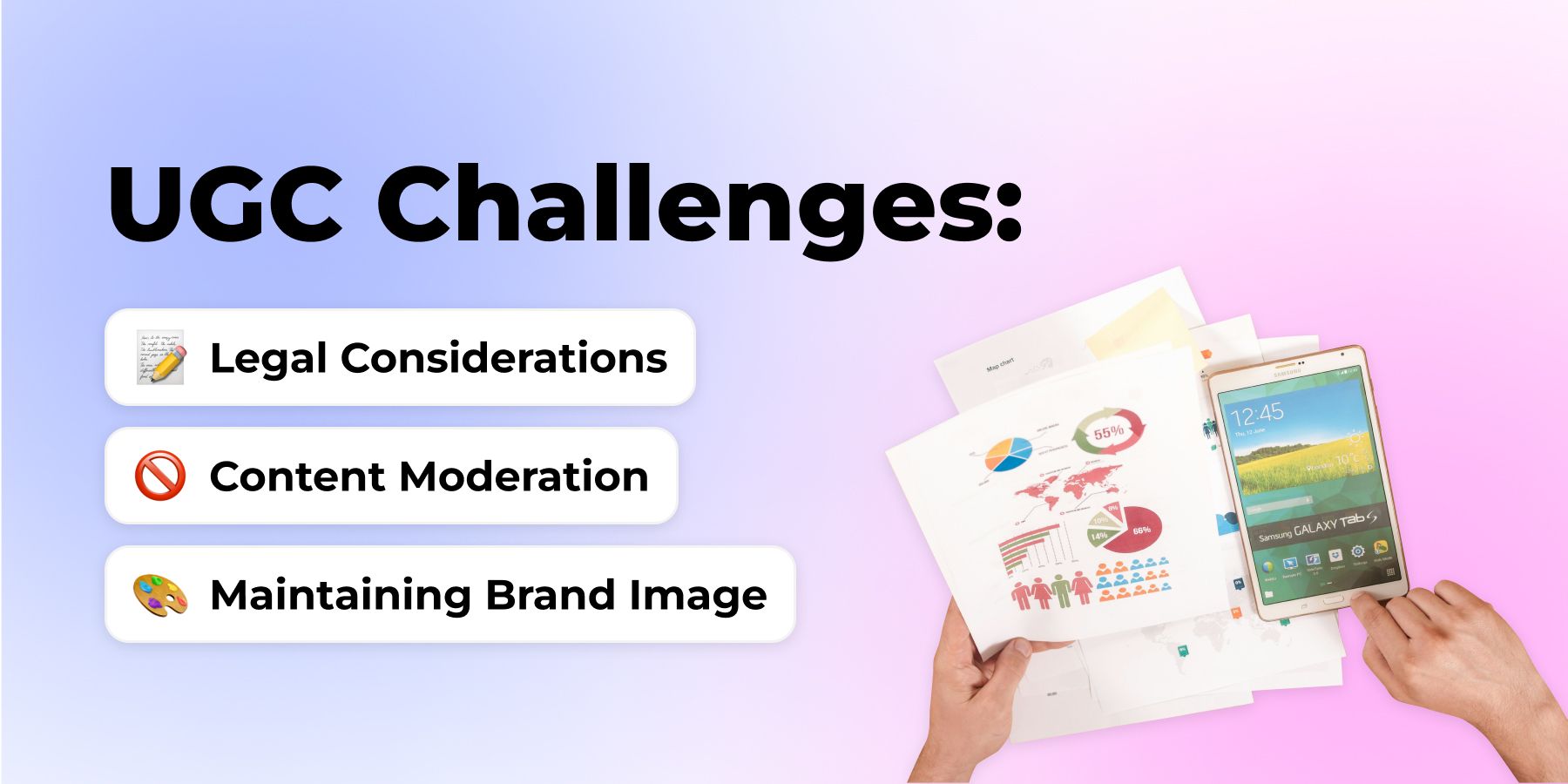
Legal Considerations
Brands must get explicit permission to use UGC in ads. Always clarify usage rights - how the content will be used, and keep written consent.
Example: An apparel brand can add a consent clause to the hashtag contest terms.
Also, watch for copyright issues. Don’t use UGC with unlicensed music, logos, or branded items.
Example: A fitness brand needs to ensure that background music or gym equipment in user videos doesn’t violate rights.
Content Moderation
Not all UGC is safe or appropriate. Set rules to filter out offensive, misleading, or off-brand submissions. Create a review process to catch issues early and avoid public backlash.
Work with trusted creators and use moderation tools to streamline the process and protect your brand.
Maintaining Brand Image
UGC should match your brand’s look and message. Set clear visual and messaging guidelines.
Example: Apple selects user photos that reflect its clean, premium aesthetic.
Choosing creators vs. influeners who align with your values helps keep your content consistent across campaigns.
UGC videos starting at $80

12900+ Vetted Creators in USA
FAQ
What does UGC mean?
UGC, or User-Generated Content, refers to any form of content—videos, images, reviews, or comments—created by real users rather than the brand. It's often shared voluntarily and reflects genuine experiences, making it one of the most trusted and influential forms of marketing content today.
How to create UGC ads for free?
You can create free UGC ads by repurposing existing customer content (with permission), launching hashtag contests to encourage users to create and share content, or experimenting with AI-generated video content that mimics the look and feel of real UGC.
What is UGC in marketing?
User-generated content (UGC) refers to authentic content created by consumers rather than brands. It includes reviews, testimonials, social media posts, and videos that showcase real user experiences.
Do UGC creators make money?
Yes, UGC creators can earn through brand collaborations, affiliate marketing, and content licensing. Many brands pay creators to produce authentic promotional content.
What is the UGC meaning?
UGC stands for User-Generated Content—any content created by unpaid contributors, often consumers, rather than the brand itself.
Is UGC legal?
UGC is legal as long as brands obtain proper permissions to use consumer-generated content in their advertisements. Always credit creators and follow copyright laws.
What is a UGC example?
A common UGC example is a customer posting a video ad review of a product on TikTok, which a brand then repurposes into a paid ad campaign on social media platforms like Facebook or Instagram.
Table of Contents
What Are UGC Ads?
How to create UGC Ads?
Anatomy of a High-quality UGC Ad
Types of UGC Ads
6 Benefits of UGC Ads
How to Use UGC in Facebook Ads
UGC Ads Examples from Successful UGC Campaigns
Challenges of UGC Ads
FAQ

Work with UGC creators from  USA
USA

 USA
USA

Devin
Santa Rosa Beach

Samantha
Wilmington

Courtney
Plover

Philip
Frisco
